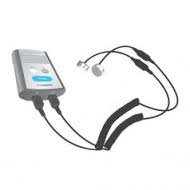Ultrasound is used in medicine in several different ways:
Diagnostic:

Ultrasound for diagnosis is often referred to by it’s slang term ‘scanning’ or incorrectly called medical ultrasound. But should really be called or sonography or diagnostic sonography or ultrasonography. Ultrasound to create images uses pulsed sound waves in the upper spectrum with frequencies higher than those audible to humans (>20,000 Hz). Ultrasonic images (sonograms) are created when the sound waves (pulses) ‘echo’ off tissues with different reflection properties and are recorded/displayed as an image.
The waves lengths used vary but for deeper structures 1-6 mhz is commonly used (this has the advantage of going deeper due to the wave length but offers low quality images) Wavelengths of up to 18mhz are common and offer better resolution but at the expense of depth. Most machines will match probes and wavelengths to offer the best combination of depth and image quality. Although lots of different types of images can be created the most common is the B-mode (brightness) image, which displays the acoustic impedance of a two-dimensional cross-section of tissue (a 2d flat image). 3d can be achieved and is popular in pregnancy scanning. Doppler can display blood flow, there are also methods to display the motion of tissue over time, the location of blood, the presence of specific molecules, and the stiffness of tissue. Sometimes a contrast medium is needed to display structures or offer more detail know as contrast imaging
Other than diagnosis ultrasound imaging is used frequently to ‘guide’ procedures most commonly injections into specific structures and ‘draining’ of fluids (cysts etc.).
Physiotherapy or Physical Therapy Ultrasound:

Therapeutic ultrasound in musculoskeletal conditions uses the principle of alternating compression and rarefaction within a frequency of 0.7 to 3.3 MHz. Primarily this has two main effects:
- Thermal effects – These are not primarily what therapeutic ultrasound is used for but they do appear in all forms of therapeutic ultrasound to some degree. Simply put the energy from the ultrasound wave is absorbed by the tissues and creates mechanical movements within the tissues which both generate heat energy.
- Non Thermal Effects – There are two non thermal effects that are considered to be positive stable cavitation and acoustic streaming. Unstable cavitation is an effect that is actively avoided in therapeutic ultrasound (but is used in HIFU below). Stable Cavitation is the formation (and growth) of gas bubbles by accumulation of dissolved gas it helps with the second non thermal effect. Acoustic Streaming creates ‘eddying’ of fluids near a vibrating structure (this could be a cell membranes affected by ultrasound) and also on the surface of stable cavitation gas bubbles (which is why stable cavitation helps). Acoustic streaming positively affects diffusion rates & membrane permeability. Sodium ion permeability is altered and calcium ion transport is modified changing protein synthesis & cellular secretions. The combined effects of stable cavitation and acoustic streaming is ‘up regulation’, increasing the activity levels of the whole cell. Although ultrasound starts this process it is the increased cellular activity which is responsible for the therapeutic effects.
High-intensity focused ultrasound (HIFU)
Uses ultrasound to heat or ablate tissue (often through cavitation). HIFU is most commonly used to destroy tissue, such as tumors, via thermal and mechanical mechanisms. Similar to ultrasonic imaging in many ways but using lower frequencies (from 0.250 to 2 MHz) and continuous, rather than pulsed waves to achieve the necessary higher doses to achieve the destructive effects. However, pulsed waves may also be used if mechanical rather than thermal damage is desired. Acoustic lenses or phased arrays (a more modern method) are often used to achieve the necessary intensity at the target tissue without damaging the surrounding tissue. HIFU is normally used with imaging to make sure you ‘hit’ the right issue.
Thermal: When used at thermal doses the temperature of tissue at the focus will rise to between 65 and 85 °C, destroying the tissue by coagulative necrosis (if tissue is elevated above 60 °C for longer than 1 second the process is irreversible).
Inertial Cavitation: At high enough acoustic intensities, cavitation (microbubbles forming and interacting with the ultrasound field) can occur. Microbubbles implode and create jets that can mechanically damage tissue.
Stable Cavitation: Stable cavitation creates microstreaming which induces high shear forces on forces and leads to apoptosis. Strong streaming may cause cell damage but also reduces tissue temperature via convective heat loss.
LIPUS (Low intensity pulsed ultrasound):

Low intensity pulsed ultrasound (LIPUS) is used as a therapy to support bone healing after fractures, osteomies, or delayed healing. LIPUS generally uses 1.5 MHz frequency pulses, with a pulse width of 200 μs, repeated at 1 kHz, at uses low average intensities 0.1 W/cm2 have been shown to improve bone healing.